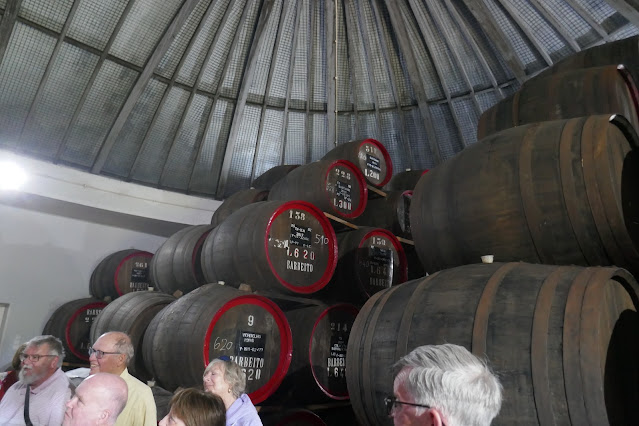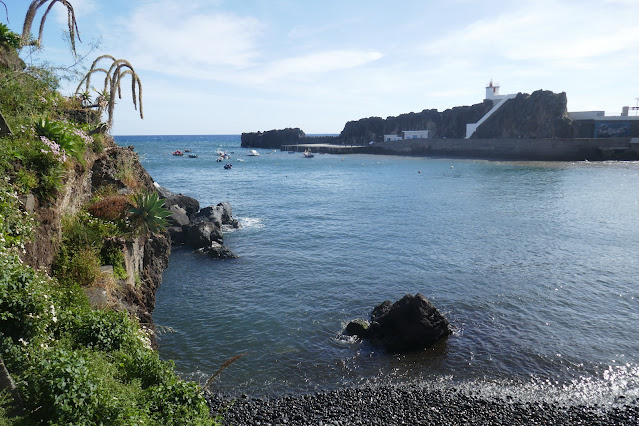A Deep Valley, a Glass of Madeira and a Seaside Village
A Brief Introduction
 |
| Portugal |
 |
| Madeira |
 |
| Madeira |
A Disappointing Morning
We had booked and paid for an afternoon excursion, our plan for the morning was to make it up as we went along, but even that simple strategy
went wrong. Madeira’s benign climate makes it a 12-month tourist destination, but the high mountains can at any time snag a passing cloud, thus ensuring sufficient rainfall to keep the island green, the gardens blooming and the crops healthy. Without rain Madeira would be like the nearby Islas Desertas, unsettled and without visitors, but like every other tourist we had selfishly hoped the rain would fall on somebody else’s week, not ours
It cleared up sufficiently for us to venture out for coffee and cake – a regular pleasure on the mainland, but not one that had
hitherto fitted our schedule here. The café, a few steps down from the road
and festooned with patrons’ wet weather clothing, felt like a damp basement. The coffee was fine, but our pasteis de nata fell well short of the Algarve's best – or was that just the weather?
We wiled away the rest of the morning with a little shopping and sheltering. By lunchtime the rain had gone and we sat outside the café
opposite out hotel and drank a beer. A little later we were at the bus stop waiting to be
picked up for our excursion,
Miradouro Pico dos Barcelos
Our driver filled his minibus with people waiting expectantly by other bus stops or outside hotels and drove us towards Santo
António, a parish in the northwest corner of Funchal. From the coast the land
rises steadily to the foot of the mountains, but just below Santo Antonio a
ridge rises to some 335m (1165ft). The summit offers 360° views, so the
municipality has thoughtfully constructed a miradouro (viewpoint).
Westward we looked across Funchal and the Atlantic …
 |
| Funchal and the Atlantic Ocean from Pico dos Barcelos |
… while to the north the city climbs the first wave of the interior uplands.
 |
| Looking north from the Picos dos Bracelos |
Also looking north, but down from the ridge, is Santo António itself. The typical local church is where a young man who would bring fame to
Santo António took his first communion. Cristiano Ronaldo, arguably the
greatest living Madeiran, was born nearby on the 5th of February 1985. Almost
universally regarded as the best European footballer
of his generation, his career included spells at Sporting Lisbon, Manchester United,
Real Madrid and Juventus, and over 200 international appearances Portugal.
 |
| Santo António |
Miradouro Eira do Serrado
The rather more dramatic Miradouro Eira do Serrado is 10 km north, the drive into the mountains normally taking around 20 mins, but not
today. Just outside the city the road runs through a narrow defile which was
blocked by a broken-down digger. Rather than wait for the rescue equipment
our driver headed back into town to find an alternative route.
Before reaching the countryside, we passed the stadium of Maritimo, Funchal’s leading football
club. Founded in 1910 they started playing in the Portuguese League in 1973, first
reached the top tier in 1977 and have remained there since 1985. [Update: they would lose that status at the end on 2022-23 season and now play in the second tier alongside Nacional, Funchal’s other
professional club.]
Three hundred metres further on we passed the ground – stadium would be an overstatement – of Andorinha Football Club where Cristiano
Ronaldo’s played as a child. He moved to Nacional juniors aged 10 and two
years later was signed by Sporting Lisbon after a three-day trial. He made his
debut for the first team at 17, and at 18 moved to Manchester United.
The Miradoura at 1095m (3,600 ft) looks down on the isolated village of Curral das Freiras sitting on a step on the lip of the valley. When first settled the land belonged to João Gonçalves Zarco one of the island's co-discoverers, but at first only the desperate tried to wring a living from this isolated valley.
 |
| Curral das Freieras |
More organised agriculture arrived in 1462 when Zarco granted the land to João Ferreira and his wife Branca Dias. In 1480 their grand-daughter
sold the land to Zarco’s son, João Gonçalves da Câmara, who donated it to the
Convento of Santa Clara. The valley was the perfect place for nuns to do
whatever nuns do without interruption and the settlement previously known as
Curral de Sierra – corral of the mountains – became Curral das Freiras – corral
of the nuns.
Much work was done terracing the valley sides below the village…
 |
| Terracing opposite central Curral das Freiras |
….and eventually it was linked to Funchal by a tunnel.
 |
| The modern road linked to Funchal by tunnel |
Wild flowers are abundant on the valley side including one known as Pride of Madeira. I know little about flowers but these look like
lupins to me, maybe they are.
 |
| Pride of Madeira |
Barbeito Madeira
Our descent was aided by the newly cleared and
reopened defile. From there we veered further west, away from the city, though there
was plenty of development in the ‘countryside.’
Above the village of Câmara de Lobos we took a minor road to the Barbeito winery.
 |
| Barbeito |
The company was founded in 1946 by Mário Barbeito de Vasconcelos and remains a family company. They specialise in making Madeira
wine, the fortified sweet wine, oxidised by heat before bottling. I described the
process for making Madeira when we visited Blandy’s in Funchal and will not repeat myself here though
I will note that ‘normal; wines are made on Madeira too, but they are labelled Madeirense
not Madeira..
 |
| Stainless steel tanks, Barbeito Winery |
The heyday of Maderia was the late 18th and early 19th centuries. At one time there 70 British owned Madeira houses, and many others besides,
but their best export market were the British colonies in North America and then
the new-forged United States of America. The second half of the 19th century Madeira
was cursed with diseases of vines, first odium, then phylloxera and as the
American market struggled to recover along came Prohibition. There are now 8
Madeira producers, Blandy’s (AKA The Madeira Wine Company) are the only surviving
British family firm.
 |
| Barbeito |
Barbeito started when the Madeira market looked doomed, but they survived. In 1991 they dropped out of the bulk trade feeling they were
too small, and concentrated on quality. A brave decision at the time, but
Madeira’s recovery could only come from concentrating on quality.
 |
| Barbeito barrels |
The showed us round their facility, gave us a lecture and finally a glass of wine, or more precisely, Rainwater. When barrels stood
on the quay awaiting export some were, inevitably, rained on. It was thought
this produced a lighter wine and the Rainwater style of Madeira was born, It is
made deliberately these days (the meteorological method was always more in the
imagination than on the palate) and was always popular in the United States. Barbeito’s
Rainwater was light, fresh, clean and medium dry, like a softer version of
Blandy’s sercial. I liked it very much, it would make an excellent aperitif and
would be a better companion for cheese than the heavier sweeter wines. We were
told they are having some success in reviving the American liking for
Rainwater, and I would not object if some of it came our way.
Câmara de Lobos
Leaving the good people of Barbeito, we drove down into Câmara de Lobos, the main settlement of the eponymous municipality. Câmara de Lobos was given city status in 1996, but the centre looks more like a village surrounded by a banana-packed amphitheatre.
 |
| Câmara de Lobos - all those bananas are watching, you know |
When João Gonçalves Zarco first landed here he also saw the amphitheatre, enhanced by the two rocky peninsulas….
 |
| Eastern side of the Harbour, Câmara de Lobos |
…that create the natural harbour.
 |
| Western side of the harbour, Câmara de Lobos |
The harbour and beach were full sea mammals, sounding and looking like a debating chamber (câmara in Portuguese). Soon the settlement was known as Câmara de Lobos – Chamber of Wolves - but Madeira has no wolves. There is a story that Zarco’s sailors could not tell the seals’ barking from the howling of wolves, but I cannot believe that. The ‘sea mammals’ were probably monk seals, they have gone now (they dislike humans) but there is a colony on the Islas Desertas, the only one outside the Mediterranean. But the Portuguese for seal is selo. I looked up Portuguese Wikipedia and it used the phrase lobos marinhos and Wikipedia’s translate facility renders this as sea lion. So that settles it, except that Google translate insists that sea lion is leão marinho (lit. sea lion) while lobo marinho means sea wolf. I might be overthinking this, so let’s settle for Parliament of Seals and hope they do a better job than the non-seals we elect.
There are few boats out in the harbour, they are all on what might elsewhere be the car park.
 |
| Parked boats, Câmara de Lobos |
The actual car park is further back. I rarely, if ever, photograph car parks, but cropping out the vehicles as far as possible…
 |
| Bougainvillea, Câmara de Lobos |
…leaves the spectacular bougainvillea on the rear wall.
Câmara de Lobos is a pleasant little place, but we only had time for a quick look round. It made me wonder why it is the focus of so many tours.
Winston Churchill paused in Madeira in 1899 as a young army officer on his way to the Boer War. He returned as a tourist in 1949 and
1950 after his wartime stint as prime minster and again in 1956 after his second
stint, staying at Reid’s Hotel. He enjoyed painting, and frequently visited Câmara
de Lobos on painting trips. This is its USP, and the reason why British tourist
are always taken here.
 |
| Winston Churchill Paining in Câmara de Lobos I do not know if this photo is still in copyright, if it my apologies to the copyright holder |
I admit to a frisson of excitement when (pre-blog) I climbed ancient steps in Egypt’s Siwa Oasis to the room where the oracle told Alexander
the Great that he was the son of Zeus. Sadly, standing where Winston Churchill
once painted a picture does give the same feeling. Even less exciting is the
information that Margaret and Dennis Thatcher spent their honeymoon in the
Savoy Hotel, just down the road from Reid’s. Both hotels feature in the post Madeira(2).
Introduction
Part 1: A First Look at Central Funchal
Part 2: Mercado and Monte Palace Gardens
Part 3: Funchal to Santana
Part 4: Eira do Serrado and Câmara de Lobos
Part 5: Photography Museum and Madeira Botanical Garden
Part 6:Eating and Drinking


No comments:
Post a Comment